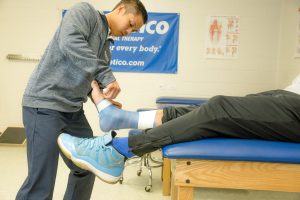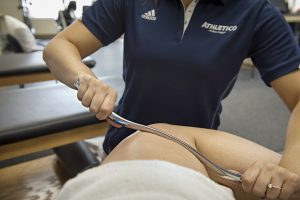
Understanding the 3 Phases of Muscle Healing
8 CommentsMuscle mass accounts for 40-45 percent of total body weight,1 which makes it no surprise that muscle injuries can account for anywhere between 10-55 percent of all sustained sports injuries.2 With such a prevalence of muscle-related injuries, it’s important to understand how muscles heal, which includes three phases: Destruction, Repair and Remodeling.2
 Destruction: This phase starts when injury occurs, most likely by a contusion or strain. Ninety percent of all muscular sports injuries occur via these two mechanisms2. A contusion is a direct force to the muscle that causes injury, while a strain occurs when the muscle is subjected to excessive forces that lead to failure of the muscle fibers. During either type of injury, muscle fibers and small blood vessels tear, filling the injured area with blood. Contained within that blood are inflammatory cells that infiltrate the newly injured area. Amazingly, muscle tissue has a mechanism that “seals off” the injured area to make sure the destruction and subsequent repair phases only occur at the injured site. This process occurs throughout the first few days after injury.1
Destruction: This phase starts when injury occurs, most likely by a contusion or strain. Ninety percent of all muscular sports injuries occur via these two mechanisms2. A contusion is a direct force to the muscle that causes injury, while a strain occurs when the muscle is subjected to excessive forces that lead to failure of the muscle fibers. During either type of injury, muscle fibers and small blood vessels tear, filling the injured area with blood. Contained within that blood are inflammatory cells that infiltrate the newly injured area. Amazingly, muscle tissue has a mechanism that “seals off” the injured area to make sure the destruction and subsequent repair phases only occur at the injured site. This process occurs throughout the first few days after injury.1
Treatment Implications: During this phase, immobilization with braces, splints, crutches or even simple taping techniques can be applied. Brief immobilization for 3-7 days can assist with minimizing pain and decreasing the effects of the destruction phase to only injured tissue. Application of RICE (Rest, ice, compression, elevation) can also decrease the detrimental effects of the destruction phase.
Repair: During this important phase, a cell called a macrophage is introduced into the injured site. A macrophage “eats” and “cleans away” the dead tissue and dry blood caused by the injury. Once this is complete, another cell – called a satellite cell – is released into the injured area. Satellite cells transform into myoblast cells, which group together to create new muscle fibers. However, unlike a broken bone that is repaired by regenerating only new bone, an injured muscle is not replaced with only new muscle fibers. Another cell, called a fibroblast, also produces connective tissue at the injured site. It is a combination of connective tissue and muscle fibers that repair the injured muscle. In addition, new blood vessels and nerves generate during this phase. This repair phase commonly is peaking about two weeks after injury.1
Treatment Implications: Transitioning from immobilization to early mobilization will occur at this time. Mobilization of the muscle can encourage faster regrowth of blood vessels and muscle fibers, as well as decrease scar formation and increase tensile strength of the muscle fibers.2 The expertise of physical therapists is important during this phase, as they can help select the appropriate intensity of exercises. Typically gentle exercises called isometrics, in which you contract the muscle but don’t allow movement of a joint or limb, will be implemented first. Progression to isotonic exercises in which you strengthen the muscle through its full range of motion occurs next. This, in combination with gentle stretching, is standard during the repair phase.
 Remodeling: This stage can have a considerable overlap with the repair phase. During remodeling, the regenerating muscle fibers and connective tissue continue to mature and are being oriented into the final scar tissue. This stage is important for the manner in which the scar tissue is being oriented. Typically, muscle issue is oriented in straight lines. When the tissue repairs itself, the mixture of new muscle fibers and connective tissue is randomly oriented. Treatment during this phase can assist the new tissue to regenerate into parallel lines, like a pile of logs, instead of one big clump, like a ball of yarn.
Remodeling: This stage can have a considerable overlap with the repair phase. During remodeling, the regenerating muscle fibers and connective tissue continue to mature and are being oriented into the final scar tissue. This stage is important for the manner in which the scar tissue is being oriented. Typically, muscle issue is oriented in straight lines. When the tissue repairs itself, the mixture of new muscle fibers and connective tissue is randomly oriented. Treatment during this phase can assist the new tissue to regenerate into parallel lines, like a pile of logs, instead of one big clump, like a ball of yarn.
Treatment implications: Manual therapy along with specialized treatment techniques such as Graston and ASTYM can help facilitate the orientation of this new scar tissue as well as prevent restrictions in the scar tissue. This is important for decreasing the likelihood of reinjuring the tissue. Returning to regular functional activity by normalizing mechanics, regaining full strength through isokinetic exercises, and sports-specific training can occur during this time.
Physical Therapists Can Help
When treating patients with musculoskeletal injuries, physical therapists are not only selecting exercises based on the deficits that are observed during the patient’s evaluation, but also identifying and respecting the current phase of healing. When combining these two approaches, patients can return to full activity. Taking into account the stage of healing along with information obtained from the evaluation, allows the therapist to formulate an individualized treatment plan for optimal healing.
Schedule an appointment at an Athletico near you today!
The Athletico blog is an educational resource written by Athletico employees. Athletico bloggers are licensed professionals who abide by the code of ethics outlined by their respective professional associations. The content published in blog posts represents the opinion of the individual author based on their expertise and experience. The content provided in this blog is for informational purposes only, does not constitute medical advice and should not be relied on for making personal health decisions.
References
- Huard J, Li Y, Fu, FH. Muscle Injuries and Repair: Current Trends in Research. The Journal of Bone and Joint Surgery. 2002; 84-A,5: 822-832.
- Jarvinen TAH, Jarvinen TLN, Kaariainen M, Kalimo H, Jarvinen M. Muscle Injuries: Biology and Treatment. The American Journal of Sports Medicine. 2005; 33(5): 745-764.

8 Comments
Anjell
Hi,
I actually have a question. During this process does it cause any level of pain? I only ask because I suffer from fibromyalgia and I recently implemented hydrolyze collagen to my diet. Since then I have been experiencing pain. Pain and discomfort that I never felt before. So, I guess I’m wondering if my body is healing, repairing itself or not?
Thank You 🙏🏽
Athletico
Hi Anjell – Your health is important to us. Please give us a call at 1-877-ATHLETICO so we can discuss your symptoms/injury. Thanks!
Daman
Hello
I have pain in my elbow from past 2 months. In between i took little rest and calcium dose but still when i go to gym i feel pain.
I think i have injured mu tissues a lot.
Please help
Athletico
Thanks for reaching out Daman. Please call our injury hotline at 1-877-ATHLETICO (877-284-5384) or schedule a free assessment to discuss your questions with one of our experts: https://www.athletico.com/FreeAssessment
gabriel
hi
i have a question
what happens if a entire strip of muscle is damaged or taken out
will it repair itself or will it not
Athletico
Hi Gabriel – Thanks for reaching out. Please call our Injury Hotline at 1-877-ATHLETICO (877-284-5384) to discuss your questions with one of our experts.
Aurangzaib
Really awesome concept I really understood keep moving
Carlotta Slade
Repair stomach stage three